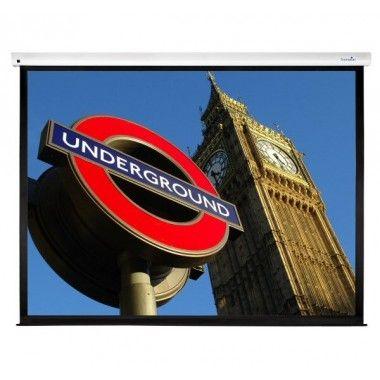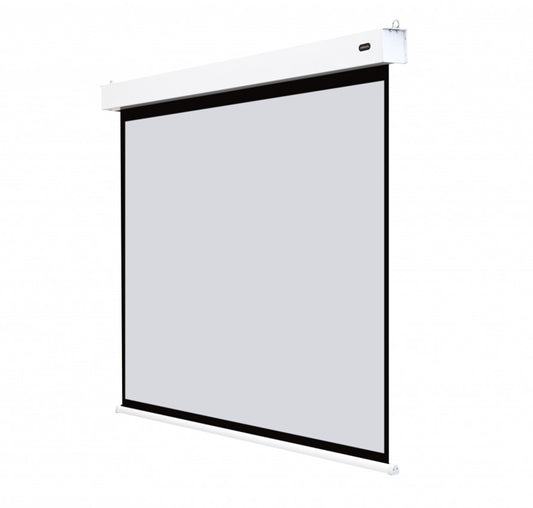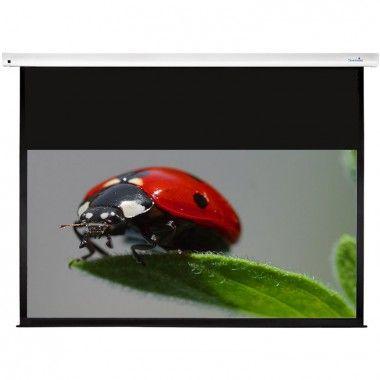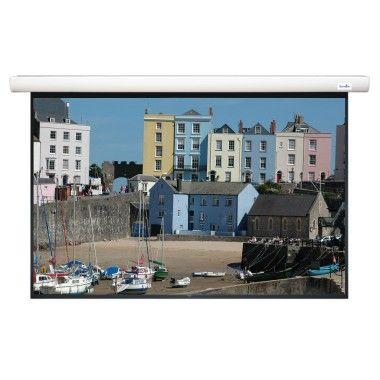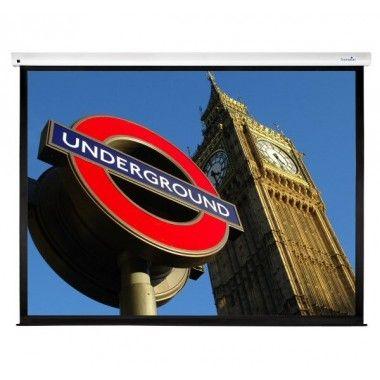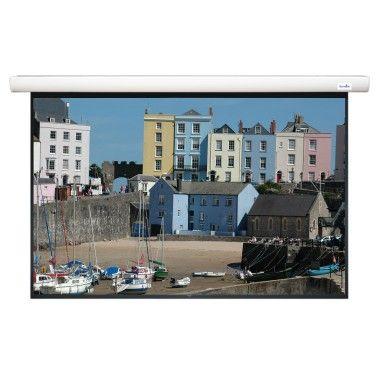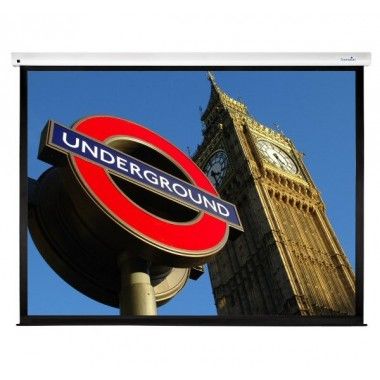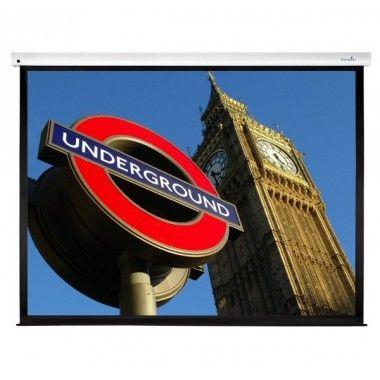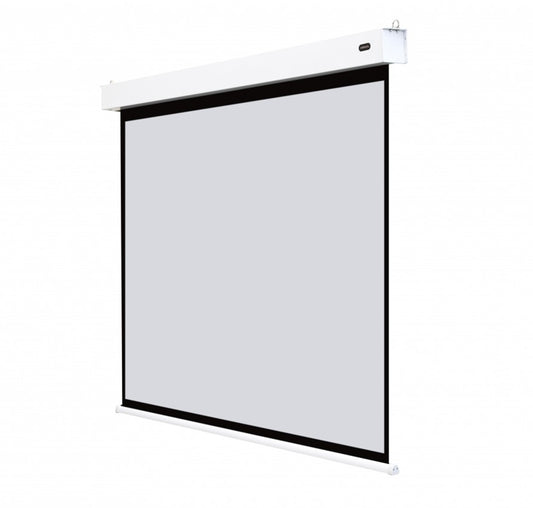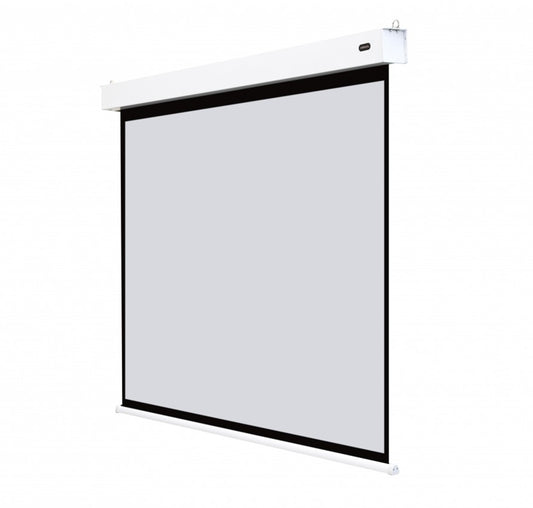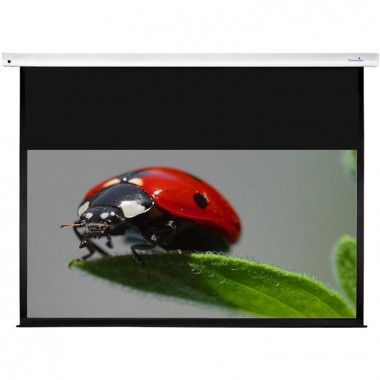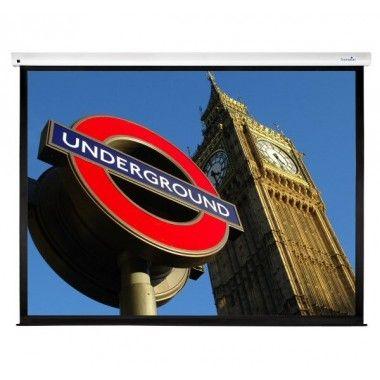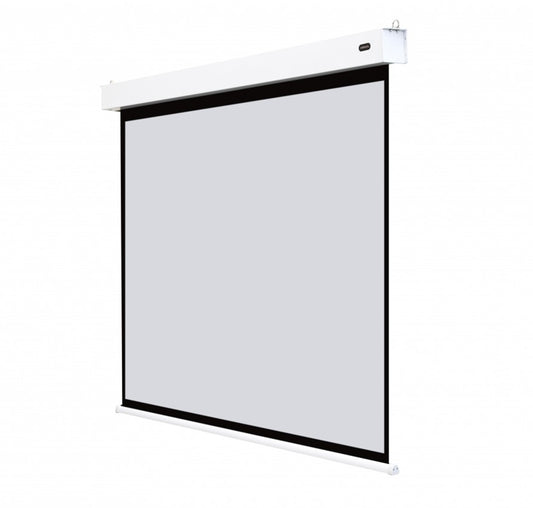Electric projection screens are a popular option for home cinema rooms, meeting rooms and in an education or training setting.
They are controlled with a built in switch, infra-red or RF (radio) remote control. The majority of the screens have a larger top border which offers flexibility in the height of the viewing area, where you show your projected image. You can set a preferred height by adjusting the built-in limit switch.
Read more in the buying guide at the bottom of the page and use the product filters to help you make the right choice.
-
Sapphire Electric Wall Screen (Radio Frequency) (4:3) 1.5m 72"
Regular price £260.00£312.00 Inc VATRegular priceUnit price per -
Sapphire Electric Wall Screen (Radio Frequency) (4:3) 1.8m 84"
Regular price £285.00£342.00 Inc VATRegular priceUnit price per -
Sapphire Electric Wall Screen (Infra Red) (4:3) 1.5m 72"
Regular price £300.00£360.00 Inc VATRegular priceUnit price per -
Celexon Electric Professional Plus Battery Powered Screen (16:9) 1.6m 72"
Regular price £333.33£400.00 Inc VATRegular priceUnit price per -
Sapphire Electric Wall Screen With Trigger Cable (Infra Red) (16:9) 1.5m 68"
Regular price £350.00£420.00 Inc VATRegular priceUnit price per -
Sapphire Electric Wall Screen With Trigger Cable (Infra Red) (16:10) 1.5m 68"
Regular price £350.00£420.00 Inc VATRegular priceUnit price per -
Celexon Electric Professional Plus Battery Powered Screen (16:9) 1.8m 81"
Regular price £354.16£424.99 Inc VATRegular priceUnit price per -
Sapphire Electric Wall Screen (Radio Frequency) (16:10) 2.0m 95"
Regular price £355.00£426.00 Inc VATRegular priceUnit price per -
Sapphire Electric Wall Screen (Radio Frequency) (4:3) 2.0m 100"
Regular price £355.00£426.00 Inc VATRegular priceUnit price per -
Sapphire Electric Wall Screen (Radio Frequency) (16:10) 1.7m 79"
Regular price £355.00£426.00 Inc VATRegular priceUnit price per -
Sapphire Electric Wall Screen (Infra Red) (4:3) 1.8m 84"
Regular price £385.00£462.00 Inc VATRegular priceUnit price per -
Sapphire Electric Wall Screen With Trigger Cable (Infra Red) (16:9) 1.8m 77"
Regular price £385.00£462.00 Inc VATRegular priceUnit price per -
Sapphire Electric Wall Screen (Radio Frequency) (16:10) 2.4m 108"
Regular price £395.00£474.00 Inc VATRegular priceUnit price per -
Sapphire Electric Wall Screen (Radio Frequency) (4:3) 2.5m 120"
Regular price £395.00£474.00 Inc VATRegular priceUnit price per -
Celexon Electric Professional Plus Battery Powered Screen (16:9) 2.0m 90"
Regular price £416.66£499.99 Inc VATRegular priceUnit price per -
Celexon Electric Professional Plus Battery Powered Screen (16:9) 2.2m 108"
Regular price £453.33£544.00 Inc VATRegular priceUnit price per -
Sapphire Electric Wall Screen With Trigger Cable (Infra Red) (16:9) 2.0m 92"
Regular price £470.00£564.00 Inc VATRegular priceUnit price per -
Sapphire Electric Wall Screen With Trigger Cable (Infra Red) (16:10) 2.0m 95"
Regular price £470.00£564.00 Inc VATRegular priceUnit price per -
Sapphire Electric Wall Screen (Infra Red) (4:3) 2.0m 100"
Regular price £470.00£564.00 Inc VATRegular priceUnit price per -
Celexon Electric Professional Plus Battery Powered Screen (16:9) 2.4m 108"
Regular price £474.99£569.99 Inc VATRegular priceUnit price per
Manual Screens Buying Guide
What are electric projector screens?
Electric wall ceiling screens are designed to be permanently wall or ceiling mounted and electronically operated when in use. These types of screens are very popular as they offer a step-up from a manual projector screen, but are still affordable. Green Monkey only select good quality brands that will give you years of use. All our electric projector screens come with a manufacturer's warranty for peace of mind.
Types of electric screens
Electric Wall screens are available in different quality options. Standard wall screens offer great value for money and durability. In some ranges, you can choose if you want these to be operated with Infra-Red or Radio Frequency remote control.
Tab-Tensioned electric projector screens offer a step up again, as these screens are made with added structure to ensure that the screen material is kept absolutely taut.
In-Ceiling screens are designed to be mounted into the ceiling so that they are totally hidden from sight when not in use.
SmartMove Electric projector screens are designed for very high ceilings.
Whichever type of electric projector screen you opt for, you will need to consider what size of screen is going to be best suited to your needs, what aspect ratio you need, and the best option for the budget you have.Electric Wall screens are available in different quality options. Standard wall screens offer great value for money and durability. In some ranges, you can choose if you want these to be operated with Infra-Red or Radio Frequency remote control.
Tab-Tensioned electric projector screens offer a step up again, as these screens are made with added structure to ensure that the screen material is kept absolutely taut.
In-Ceiling screens are designed to be mounted into the ceiling so that they are totally hidden from sight when not in use.
SmartMove Electric projector screens are designed for very high ceilings.
Whichever type of electric projector screen you opt for, you will need to consider what size of screen is going to be best suited to your needs, what aspect ratio you need, and the best option for the budget you have.
Radio Frequency or Infra-Red?
Radio Frequency (RF) and Infra-Red (IF) are two different types of energy used in remote controls to communicate commands. RF uses radio waves and IR is a sort of light that can't be seen with the naked eye. Both technologies have their advantages.
IR requires a line-of-sight in order to control your projector screen. So you will need to point your remote control directly at the projector screen in order to operate it. No RF device can interfere with the system, and it's harder to accidentally operate the screen without knowing.
RF, on the other hand, can work over much longer distances and even pass through various materials. This allows much greater flexibility of control in areas where there may be obstacles blocking the line of sight. Ideal for in-ceiling screens or projector screens that are being partially hidden from view behind a pelmet or a recess.
Standard or Tab Tensioned?
Most electric projector screens have a weighted bar built into the screen fabric which keeps the surface pulled nice and flat when in use. For most applications this is sufficient, but if you plan on mounting your projector screen somewhere drafty (for example in front of a window or over a radiator), or if you're just looking for a more premium option, Tab-tensioned screens offer the additional benefit of an inbuilt tension system to create a completely flat viewing surface. The material on a Tab Tension screen is not only pulled down by the weight of the bar at the bottom but also from the left and right side by a Nylon string. The string is periodically connected to the material via small "Tabs" hence the name Tab Tension. These screens are usually higher quality and if budget allows, are a great option for optimal viewing.
In-Ceiling Screen
Electric In-Ceiling projector screens (also known as Recessed ceiling projector screens) are designed to be mounted flush to the ceiling itself and totally hidden out of sight.
The casing will allow a discreet installation and the screen will drop down when in use. They are a popular choice for home cinema applications where you don't necessarily want the projector screen to be visible all the time. In-Ceiling projector screens are a bit more tricky to install than a standard electric projector screen. We do recommend professional installation for optimal results.
Smart-Move Electric Projector Screens
SmartMove projector screens are designed for either very high ceilings, or to avoid architectural features like windows, arches in churches, or AC vents. As well as the normal operation of the screen fabric dropping from the barrel, the barrel itself lowers into position via small built in winches. This enables the screen casing to be dropped up to 5 meters from the fixing position.
About Aspect Ratio
Aspect ratio is the shape of the viewing area of the projection screen. We offer our projector screens in a Square shape (1:1), Video Format (4:3), Widescreen (16:9) and WXGA (16:10). Square format and Video format projector screens used to be very popular, but the introduction of high-definition has pushed more users to opt for 16:9 or 16:10 aspect ratios. It's best to match the aspect ratio with the native resolution of your projector and video source.
For example, if you are mainly using your manual pull-down projector screen for a home cinema experience, most home cinema projectors will be Full HD (1080p) as this is the standard format of modern TV sets, SKY, blueray etc. Therefore we would recommend a 16:9 projector screen to match the image shape. The black borders will add contrast and improve the image quality.
If you are using your projector screen to present presentations from your work laptop, and your business projector is a WXGA projector, it's likely that a 16:10 projector screen will be the best fit.
Square projector screens allow you to project any image shape, which is great for flexibility, however, because the image is not matched with black borders, the picture quality does suffer.
Measuring for the right size screen
Finally, you need to think about the size of the electric screen that will best fit in your location. As well as looking at the overall projector screen width (commonly shown in meters - for example, 2.0m wide), you also need to look at the viewing area dimension and the case dimension. TheViewing Areais the blank white space between the black borders. This is the dimension that the actual projected picture will be. This is often shown in millimetres or diagonal inches. The case that the screen is housed in, is often quite a bit wider than the screen fabric itself. Therefore you do need to check that thiscase dimensionwill fit where you want to mount the projector screen. Especially if you are looking to mount the projector into a small space or an alcove.Finally, you need to think about the size of the electric screen that will best fit in your location. As well as looking at the overall projector screen width (commonly shown in meters - for example, 2.0m wide), you also need to look at the viewing area dimension and the case dimension. TheViewing Areais the blank white space between the black borders. This is the dimension that the actual projected picture will be. This is often shown in millimetres or diagonal inches. The case that the screen is housed in, is often quite a bit wider than the screen fabric itself. Therefore you do need to check that this case dimension will fit where you want to mount the projector screen. Especially if you are looking to mount the projector into a small space or an alcove.
Contact Us
If you need any help or advice in purchasing the right screen for your needs, please contact our sales team by using the live chat, calling 0161 850 9696 or using the contact form below.


